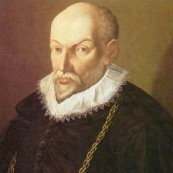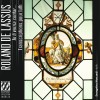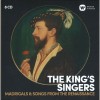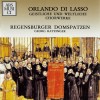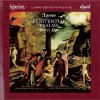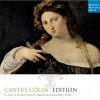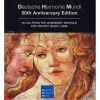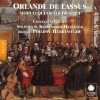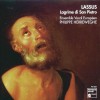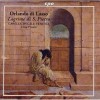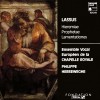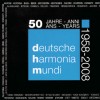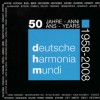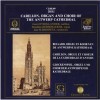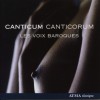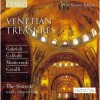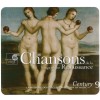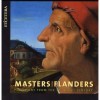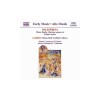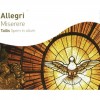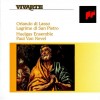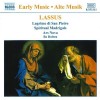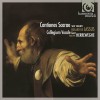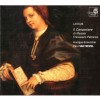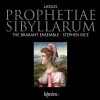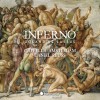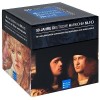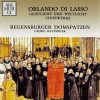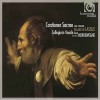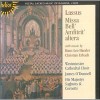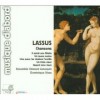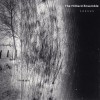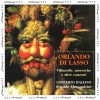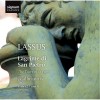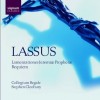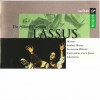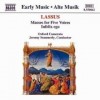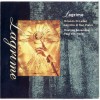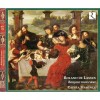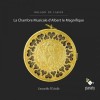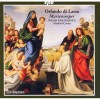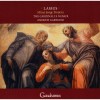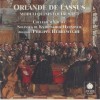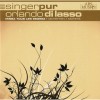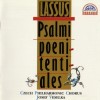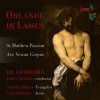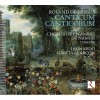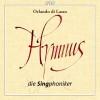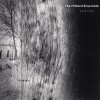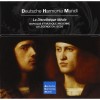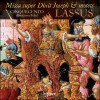Composers
Orlande de Lassus (also Orlandus Lassus, Orlando di Lasso, Roland de Lassus, or Roland Delattre) (1532 (possibly 1530) – 14 June 1594) was a Franco-Flemish composer of the late Renaissance. He is today considered to be the chief representative of the mature polyphonic style of the Franco-Flemish school, and one of the three most famous and influential musicians in Europe at the end of the 16th century (the other two being Palestrina and Victoria).
assus was born in Mons in the County of Hainaut (modern day Belgium). Information about his early years is scanty, although some uncorroborated stories have survived, the most famous of which is that he was kidnapped three times because of the singular beauty of his singing voice. At the age of twelve, he left the Low Countries with Ferrante Gonzaga and went to Mantua, Sicily, and later Milan (from 1547 to 1549). While in Milan, he made the acquaintance of the madrigalist Spirito l'Hoste da Reggio, a formative influence on his early musical style.
He then worked as a singer and a composer for Costantino Castrioto in Naples in the early 1550s, and his first works are presumed to date from this time. Next he moved to Rome, where he worked for Cosimo I de' Medici, Grand Duke of Tuscany, who maintained a household there; and in 1553, he became maestro di cappella of the Basilica di San Giovanni in Laterano, the ecumenical mother church of Rome and a spectacularly prestigious post indeed for a man only twenty-one years old. However, he stayed there for only a year. (Palestrina would assume this post a year later, in 1555.)
No solid evidence survives for his whereabouts in 1554, but there are contemporary claims that he traveled in France and England. In 1555 he returned to the Low Countries and had his early works published in Antwerp (1555–1556). In 1556 he joined the court of Albrecht V, Duke of Bavaria, who was consciously attempting to create a musical establishment on a par with the major courts in Italy. Lassus was one of several Netherlanders to work there, and by far the most famous. He evidently was happy in Munich and decided to settle there. In 1558 he married Regina Wäckinger, the daughter of a maid of honor of the Duchess; they had two sons, both of whom became composers. By 1563 Lassus had been appointed maestro di cappella, succeeding Ludwig Daser in the post. Lassus remained in the service of Albrecht V and his heir, Wilhelm V, for the rest of his life.
By the 1560s Lassus had become quite famous, and composers began to go to Munich to study with him. Andrea Gabrieli went there in 1562, and possibly remained in the chapel for a year; Giovanni Gabrieli also possibly studied with him in the 1570s. His renown had spread outside of strictly musical circles, for in 1570 Emperor Maximilian II conferred nobility upon him, a rare circumstance for a composer; Pope Gregory XIII knighted him; and in 1571, and again in 1573, the king of France, Charles IX, invited him to visit. Some of these kings and aristocrats attempted to woo him away from Munich with more attractive offers, but Lassus was evidently more interested in the stability of his position, and the splendid performance opportunities of Albrecht's court, than in financial gain. "I do not want to leave my house, my garden, and the other good things in Munich," he wrote to the Duke of Electorate of Saxony in 1580, upon receiving an offer for a position in Dresden.
In the late 1570s and 1580s Lassus made several visits to Italy, where he encountered the most modern styles and trends. In Ferrara, the center of avant-garde activity, he doubtless heard the madrigals being composed for the d'Este court; however his own style remained conservative and became simpler and more refined as he aged. In the 1590s his health began to decline, and he went to a doctor named Thomas Mermann for treatment of what was called "melancholia hypocondriaca", but he was still able to compose as well as travel occasionally. His final work was often considered one of his best pieces: an exquisite set of twenty-one madrigali spirituali known as the Lagrime di San Pietro ("Tears of St. Peter"), which he dedicated to Pope Clement VIII, and which was published posthumously in 1595. Lassus died in Munich on 14 June 1594, the same day that his employer decided to dismiss him for economic reasons; he never saw the letter.
One of the most prolific, versatile, and universal composers of the late Renaissance, Lassus wrote over 2,000 works in all Latin, French, Italian and German vocal genres known in his time. These include 530 motets, 175 Italian madrigals and villanellas, 150 French chansons, and 90 German lieder. No strictly instrumental music by Lassus is known to survive, or ever to have existed: an interesting omission for a composer otherwise so wide-ranging and prolific, during an age when instrumental music was becoming an ever-more prominent means of expression, all over Europe. The German music publisher Adam Berg dedicated 5 volumes of his Patrocinium musicum (published from 1873–1880) to Lassus' music.
Lassus remained Catholic during this age of religious discord, although not dogmatically so, as may be seen from his more worldly secular songs as well as his parody Masses and Magnificats based on secular compositions. Nevertheless the Catholic Counter-Reformation, which under Jesuit influence was reaching a peak in Bavaria in the late sixteenth century, had a demonstrable impact on Lassus' late work, including the liturgical music for the Roman Rite, the burgeoning number of Magnificats, the settings of the Catholic Ulenberg Psalter (1588), and especially the great penitential cycle of spiritual madrigals, the 'Lagrime di San Pietro' (1594).
Almost 60 masses have survived complete; most of them are parody masses based on secular works written by himself or other composers. Technically impressive, they are nevertheless the most conservative part of his output. He usually conformed the style of the mass to the style of the source material, which ranged from Gregorian chant to contemporary madrigals, but always maintained an expressive and reverent character in the final product. Some of his masses are based on extremely secular French chansons, some of which are frankly obscene (Entre vous filles de quinze ans, "Oh you fifteen-year old girls", by Clemens non Papa, gave him source material for his 1581 Missa entre vous filles, probably the most scandalous of the lot). That this practice was not only accepted but encouraged by his employer is confirmed by evidence from their correspondence, much of which has survived.
In addition to his traditional parody masses, he wrote a considerable quantity of missae breves, "brief masses," syllablic short masses meant for brief services (for example, on days when Duke Albrecht went hunting: evidently he did not want to be detained by long-winded polyphonic music). The most extreme of these is a work actually known as the Jäger Mass (Missa venatorum)—the "Hunter's Mass."
Some of his masses show influence from the Venetian School, particularly in their use of polychoral techniques (for example, in the eight-voice Missa osculetur me, based on his own motet). Three of his masses are for double choir, and they may have been influential on the Venetians themselves; after all, Andrea Gabrieli visited Lassus in Munich in 1562, and many of Lassus's works were published in Venice. Even though Lassus used the contemporary, sonorous Venetian style, his harmonic language remained conservative in these works: he adapted the texture of the Venetians to his own artistic ends.
Lassus is one of the composers of a style known as musica reservata—a term which has survived in many contemporary references, many of them seemingly contradictory. The exact meaning of the term is a matter of fierce debate, though a rough consensus among musicologists is that it involves intensely expressive setting of text, chromaticism, and that it may have referred to music specifically written for connoisseurs. A famous example of a composition by Lassus which is a representative of this style is his series of 12 motets entitled Prophetiae Sibyllarum, which is in a wildly chromatic style reminiscent of Gesualdo; some of his chord progressions in this piece were not to be heard again until the 20th century.
Lassus wrote four settings of the Passion, one for each of the Evangelists, St. Matthew, Mark, Luke and John. All are for a cappella voices. He sets the words of Christ and the narration of the Evangelist as chant, while setting the passages for groups polyphonically.
As a composer of motets, Lassus was one of the most diverse and prodigious of the entire Renaissance. His output varies from the sublime to the ridiculous, and he showed a sense of humor not often associated with sacred music: for example, one of his motets satirizes poor singers (his setting of Super flumina Babylonis, for five voices) which includes stuttering, stopping and starting, and general confusion; it is related in concept if not in style to Mozart's A Musical Joke. Many of his motets were composed for ceremonial occasions, as could be expected of a court composer who was required to provide music for visits of dignitaries, weddings, treaties and other events of state. But it was as a composer of religious motets that Lassus achieved his widest and lasting fame.
Lassus's setting of the seven Penitential Psalms of David (Psalmi Davidis poenitentiales) is one of the most famous collections of psalm settings of the entire Renaissance. The counterpoint is free, avoiding the pervasive imitation of the Netherlanders such as Gombert, and occasionally using expressive devices foreign to Palestrina. As elsewhere, Lassus strives for emotional impact, and uses a variety of texture and care in text setting towards that end. The final piece in the collection, his setting of the De profundis (Psalm 129/130), is considered by many scholars to be one of the high-water marks of Renaissance polyphony, ranking alongside the two settings of the same text by Josquin des Prez.
Among his other liturgical compositions are hymns, canticles (including over 100 Magnificats), responsories for Holy Week, Passions, Lamentations, and some independent pieces for major feasts.
Lassus wrote in all the prominent secular forms of the time. In the preface to his collection of German songs, Lassus lists his secular works: Italian madrigals and French chansons, German and Dutch songs. He is probably the only Renaissance composer to write prolifically in five languages – Latin in addition to those mentioned above – and he wrote with equal fluency in each. Many of his songs became hugely popular, circulating widely in Europe. In these various secular songs, he conforms to the manner of the country of origin while still showing his characteristic originality, wit, and terseness of statement.
In his madrigals, many of which he wrote during his stay in Rome, his style is clear and concise, and he wrote tunes which were easily memorable; he also "signed" his work by frequently using the word 'lasso' (and often setting with the sol-fege syllables la-sol, i.e. A-G in the key of C). His choice of poetry varied widely, from Petrarch for his more serious work to the lightest verse for some of his amusing canzonettas.
Lassus often preferred cyclic madrigals, i.e. settings of multiple poems in a group as a set of related pieces of music. For example, his fourth book of madrigals for five voices begins with a complete sestina by Petrarch, continues with two-part sonnets, and concludes with another sestina: therefore the entire book can be heard as a unified composition with each madrigal a subsidiary part.
Another form which Lassus cultivated was the French chanson, of which he wrote about 150. Most of them date from the 1550s, but he continued to write them even after he was in Germany: his last productions in this genre come from the 1580s. They were enormously popular in Europe, and of all his works, they were the most widely arranged for instruments such as flute and piano. Most were collected in the 1570s and 1580s in three publications: one by Pierre Phalèse the Elder in 1571, and two by Le Roy and Ballard in 1576 and 1584. Stylistically, they ranged from the dignified and serious, to playful, bawdy, and amorous compositions, as well as drinking songs suited to taverns. Lassus followed the polished, lyrical style of Sermisy rather than the programmatic style of Clément Janequin for his writing.
One of the most famous of Lassus's drinking songs was used by Shakespeare in Henry IV, Part II. English words are fitted to Un jour vis un foulon qui fouloit (as Monsieur Mingo) and sung by the drunken Justice Silence, in Act V, Scene iii.
A third type of secular composition by Lassus was the German lied. Most of these he evidently intended for a different audience, since they are considerably different in tone and style from either the chansons or madrigals; in addition, he wrote them later in life, with none appearing until 1567, when he was already well-established at Munich. Many are on religious subjects, although light and comic verse are represented as well. He also wrote drinking songs in German, and contrasting with his parallel work in the genre of the chanson, he also wrote songs on the unfortunate aspects of overindulgence.
In the preface to his collection of German songs, Lassus states that he has composed Dutch songs. However, no Dutch song has been preserved
Recently Added
| Country: | Belgium |
| Period: | Renaissance, Baroque |
Biography
Orlande de Lassus (also Orlandus Lassus, Orlando di Lasso, Roland de Lassus, or Roland Delattre) (1532 (possibly 1530) – 14 June 1594) was a Franco-Flemish composer of the late Renaissance. He is today considered to be the chief representative of the mature polyphonic style of the Franco-Flemish school, and one of the three most famous and influential musicians in Europe at the end of the 16th century (the other two being Palestrina and Victoria).
assus was born in Mons in the County of Hainaut (modern day Belgium). Information about his early years is scanty, although some uncorroborated stories have survived, the most famous of which is that he was kidnapped three times because of the singular beauty of his singing voice. At the age of twelve, he left the Low Countries with Ferrante Gonzaga and went to Mantua, Sicily, and later Milan (from 1547 to 1549). While in Milan, he made the acquaintance of the madrigalist Spirito l'Hoste da Reggio, a formative influence on his early musical style.
He then worked as a singer and a composer for Costantino Castrioto in Naples in the early 1550s, and his first works are presumed to date from this time. Next he moved to Rome, where he worked for Cosimo I de' Medici, Grand Duke of Tuscany, who maintained a household there; and in 1553, he became maestro di cappella of the Basilica di San Giovanni in Laterano, the ecumenical mother church of Rome and a spectacularly prestigious post indeed for a man only twenty-one years old. However, he stayed there for only a year. (Palestrina would assume this post a year later, in 1555.)
No solid evidence survives for his whereabouts in 1554, but there are contemporary claims that he traveled in France and England. In 1555 he returned to the Low Countries and had his early works published in Antwerp (1555–1556). In 1556 he joined the court of Albrecht V, Duke of Bavaria, who was consciously attempting to create a musical establishment on a par with the major courts in Italy. Lassus was one of several Netherlanders to work there, and by far the most famous. He evidently was happy in Munich and decided to settle there. In 1558 he married Regina Wäckinger, the daughter of a maid of honor of the Duchess; they had two sons, both of whom became composers. By 1563 Lassus had been appointed maestro di cappella, succeeding Ludwig Daser in the post. Lassus remained in the service of Albrecht V and his heir, Wilhelm V, for the rest of his life.
By the 1560s Lassus had become quite famous, and composers began to go to Munich to study with him. Andrea Gabrieli went there in 1562, and possibly remained in the chapel for a year; Giovanni Gabrieli also possibly studied with him in the 1570s. His renown had spread outside of strictly musical circles, for in 1570 Emperor Maximilian II conferred nobility upon him, a rare circumstance for a composer; Pope Gregory XIII knighted him; and in 1571, and again in 1573, the king of France, Charles IX, invited him to visit. Some of these kings and aristocrats attempted to woo him away from Munich with more attractive offers, but Lassus was evidently more interested in the stability of his position, and the splendid performance opportunities of Albrecht's court, than in financial gain. "I do not want to leave my house, my garden, and the other good things in Munich," he wrote to the Duke of Electorate of Saxony in 1580, upon receiving an offer for a position in Dresden.
In the late 1570s and 1580s Lassus made several visits to Italy, where he encountered the most modern styles and trends. In Ferrara, the center of avant-garde activity, he doubtless heard the madrigals being composed for the d'Este court; however his own style remained conservative and became simpler and more refined as he aged. In the 1590s his health began to decline, and he went to a doctor named Thomas Mermann for treatment of what was called "melancholia hypocondriaca", but he was still able to compose as well as travel occasionally. His final work was often considered one of his best pieces: an exquisite set of twenty-one madrigali spirituali known as the Lagrime di San Pietro ("Tears of St. Peter"), which he dedicated to Pope Clement VIII, and which was published posthumously in 1595. Lassus died in Munich on 14 June 1594, the same day that his employer decided to dismiss him for economic reasons; he never saw the letter.
One of the most prolific, versatile, and universal composers of the late Renaissance, Lassus wrote over 2,000 works in all Latin, French, Italian and German vocal genres known in his time. These include 530 motets, 175 Italian madrigals and villanellas, 150 French chansons, and 90 German lieder. No strictly instrumental music by Lassus is known to survive, or ever to have existed: an interesting omission for a composer otherwise so wide-ranging and prolific, during an age when instrumental music was becoming an ever-more prominent means of expression, all over Europe. The German music publisher Adam Berg dedicated 5 volumes of his Patrocinium musicum (published from 1873–1880) to Lassus' music.
Lassus remained Catholic during this age of religious discord, although not dogmatically so, as may be seen from his more worldly secular songs as well as his parody Masses and Magnificats based on secular compositions. Nevertheless the Catholic Counter-Reformation, which under Jesuit influence was reaching a peak in Bavaria in the late sixteenth century, had a demonstrable impact on Lassus' late work, including the liturgical music for the Roman Rite, the burgeoning number of Magnificats, the settings of the Catholic Ulenberg Psalter (1588), and especially the great penitential cycle of spiritual madrigals, the 'Lagrime di San Pietro' (1594).
Almost 60 masses have survived complete; most of them are parody masses based on secular works written by himself or other composers. Technically impressive, they are nevertheless the most conservative part of his output. He usually conformed the style of the mass to the style of the source material, which ranged from Gregorian chant to contemporary madrigals, but always maintained an expressive and reverent character in the final product. Some of his masses are based on extremely secular French chansons, some of which are frankly obscene (Entre vous filles de quinze ans, "Oh you fifteen-year old girls", by Clemens non Papa, gave him source material for his 1581 Missa entre vous filles, probably the most scandalous of the lot). That this practice was not only accepted but encouraged by his employer is confirmed by evidence from their correspondence, much of which has survived.
In addition to his traditional parody masses, he wrote a considerable quantity of missae breves, "brief masses," syllablic short masses meant for brief services (for example, on days when Duke Albrecht went hunting: evidently he did not want to be detained by long-winded polyphonic music). The most extreme of these is a work actually known as the Jäger Mass (Missa venatorum)—the "Hunter's Mass."
Some of his masses show influence from the Venetian School, particularly in their use of polychoral techniques (for example, in the eight-voice Missa osculetur me, based on his own motet). Three of his masses are for double choir, and they may have been influential on the Venetians themselves; after all, Andrea Gabrieli visited Lassus in Munich in 1562, and many of Lassus's works were published in Venice. Even though Lassus used the contemporary, sonorous Venetian style, his harmonic language remained conservative in these works: he adapted the texture of the Venetians to his own artistic ends.
Lassus is one of the composers of a style known as musica reservata—a term which has survived in many contemporary references, many of them seemingly contradictory. The exact meaning of the term is a matter of fierce debate, though a rough consensus among musicologists is that it involves intensely expressive setting of text, chromaticism, and that it may have referred to music specifically written for connoisseurs. A famous example of a composition by Lassus which is a representative of this style is his series of 12 motets entitled Prophetiae Sibyllarum, which is in a wildly chromatic style reminiscent of Gesualdo; some of his chord progressions in this piece were not to be heard again until the 20th century.
Lassus wrote four settings of the Passion, one for each of the Evangelists, St. Matthew, Mark, Luke and John. All are for a cappella voices. He sets the words of Christ and the narration of the Evangelist as chant, while setting the passages for groups polyphonically.
As a composer of motets, Lassus was one of the most diverse and prodigious of the entire Renaissance. His output varies from the sublime to the ridiculous, and he showed a sense of humor not often associated with sacred music: for example, one of his motets satirizes poor singers (his setting of Super flumina Babylonis, for five voices) which includes stuttering, stopping and starting, and general confusion; it is related in concept if not in style to Mozart's A Musical Joke. Many of his motets were composed for ceremonial occasions, as could be expected of a court composer who was required to provide music for visits of dignitaries, weddings, treaties and other events of state. But it was as a composer of religious motets that Lassus achieved his widest and lasting fame.
Lassus's setting of the seven Penitential Psalms of David (Psalmi Davidis poenitentiales) is one of the most famous collections of psalm settings of the entire Renaissance. The counterpoint is free, avoiding the pervasive imitation of the Netherlanders such as Gombert, and occasionally using expressive devices foreign to Palestrina. As elsewhere, Lassus strives for emotional impact, and uses a variety of texture and care in text setting towards that end. The final piece in the collection, his setting of the De profundis (Psalm 129/130), is considered by many scholars to be one of the high-water marks of Renaissance polyphony, ranking alongside the two settings of the same text by Josquin des Prez.
Among his other liturgical compositions are hymns, canticles (including over 100 Magnificats), responsories for Holy Week, Passions, Lamentations, and some independent pieces for major feasts.
Lassus wrote in all the prominent secular forms of the time. In the preface to his collection of German songs, Lassus lists his secular works: Italian madrigals and French chansons, German and Dutch songs. He is probably the only Renaissance composer to write prolifically in five languages – Latin in addition to those mentioned above – and he wrote with equal fluency in each. Many of his songs became hugely popular, circulating widely in Europe. In these various secular songs, he conforms to the manner of the country of origin while still showing his characteristic originality, wit, and terseness of statement.
In his madrigals, many of which he wrote during his stay in Rome, his style is clear and concise, and he wrote tunes which were easily memorable; he also "signed" his work by frequently using the word 'lasso' (and often setting with the sol-fege syllables la-sol, i.e. A-G in the key of C). His choice of poetry varied widely, from Petrarch for his more serious work to the lightest verse for some of his amusing canzonettas.
Lassus often preferred cyclic madrigals, i.e. settings of multiple poems in a group as a set of related pieces of music. For example, his fourth book of madrigals for five voices begins with a complete sestina by Petrarch, continues with two-part sonnets, and concludes with another sestina: therefore the entire book can be heard as a unified composition with each madrigal a subsidiary part.
Another form which Lassus cultivated was the French chanson, of which he wrote about 150. Most of them date from the 1550s, but he continued to write them even after he was in Germany: his last productions in this genre come from the 1580s. They were enormously popular in Europe, and of all his works, they were the most widely arranged for instruments such as flute and piano. Most were collected in the 1570s and 1580s in three publications: one by Pierre Phalèse the Elder in 1571, and two by Le Roy and Ballard in 1576 and 1584. Stylistically, they ranged from the dignified and serious, to playful, bawdy, and amorous compositions, as well as drinking songs suited to taverns. Lassus followed the polished, lyrical style of Sermisy rather than the programmatic style of Clément Janequin for his writing.
One of the most famous of Lassus's drinking songs was used by Shakespeare in Henry IV, Part II. English words are fitted to Un jour vis un foulon qui fouloit (as Monsieur Mingo) and sung by the drunken Justice Silence, in Act V, Scene iii.
A third type of secular composition by Lassus was the German lied. Most of these he evidently intended for a different audience, since they are considerably different in tone and style from either the chansons or madrigals; in addition, he wrote them later in life, with none appearing until 1567, when he was already well-established at Munich. Many are on religious subjects, although light and comic verse are represented as well. He also wrote drinking songs in German, and contrasting with his parallel work in the genre of the chanson, he also wrote songs on the unfortunate aspects of overindulgence.
In the preface to his collection of German songs, Lassus states that he has composed Dutch songs. However, no Dutch song has been preserved
